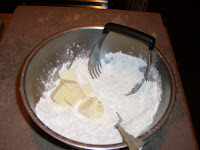Great for breakfast, lunch and dinner, biscuits are basic . . . but this recipe goes way beyond basic! I’ve served them piping hot with bacon and eggs, with fried chicken or as a side with soups. Actually I’ve even made mini ham and sweet potato biscuits for cocktail parties . . . and they were a hit.
But whenever my thoughts turn to biscuits, I am reminded of freshman foods class and the quick breads unit. Consequently, I couldn’t help myself — you’ll find the criteria for judging your own biscuits at the end of this post. And, yes, this recipe comes out on top every time! The sweet potato purée creates a flavorful and slightly moist biscuit. I can eat them without butter but Barry insists that a pat of butter makes them even better.
Sweet Potato Biscuits Makes 27 (1 3/4") biscuits
1 3/4 cups all-purpose flour
2 tablespoons brown sugar
2 1/2 teaspoons baking powder
1 teaspoon salt

1/2 teaspoon baking soda
6 tablespoons chilled butter – cut into pieces (unsalted preferred, but I’ve also used salted with no adverse effects . . . and I did not decrease the salt)
3/4 cup chilled sweet potato purée (cook one average-sized sweet potato in microware, peel & mash with a little-1 to 2 Tbsp.-buttermilk to create the purée)
1/3+ cup buttermilk
1. Adjust oven racks so that biscuits can be baked in lower quarter of oven. Preheat oven to 425°. Spray a baking pan; I’m using what is known as a “quarter” size sheet pan (9”x13”).
2. In a large bowl, whisk together the flour, sugar, baking powder, salt and baking soda.
3. With a pastry blender (or the flat blade of an electric mixer), cut butter into the dry mixture from step #2 until it resembles coarse meal, with some pea-size lumps of butter remaining.
4. With a fork, gently stir in sweet potato purée (if using a mixer, use low speed & just barely mix in); sprinkle most of the 1/3 cup buttermilk over the dry areas in the mixture, gently stir in, adding more as needed. Do NOT overmix – at this point there are usually a few areas where you can see some dry mixture but the majority of the dough should be able to be rounded into a ball using your hands. When dough begins to form a ball, turn out on a lightly floured surface.
 |
| Notice that there is still dry ingredients that need to be incorporated into the dough. |
5. Begin to gently knead, working the dry mixture into the dough – knead about 5 or 6 times. If dough is sticky, work in a little additional flour.
6. Shape into a disk, and pat or roll to an even 1” thickness.
 |
| Flecks of sweet potato are evident in the kneaded dough. |
7. With a floured 1 3/4" biscuit cutter, cut out biscuits as close together as possible (be sure to cut without twisting cutter or biscuits make have an uneven shape). Gather together scraps, and repeat to cut out more biscuits (the more you re-shape, the more the gluten is developed resulting in tougher biscuits).
8. Arrange biscuits snugly in prepared pan (to help them stay upright). Brush lightly with extra buttermilk.
9. Place pan in lower section of oven and bake until golden, rotating once, 20 to 24 minutes.
 |
| When turned over, the biscuits should be brown on the underside. |
BASIC CRITERIA for JUDGING BISCUITS
There are two types of biscuits – rolled and dropped. Both are leavened by baking powder and contain similar ingredients but differ in proportion of liquid and method of preparation. Rolled biscuits are more identical and dropped biscuits are more irregular in shape.
Following are the five standard criteria for judging rolled biscuits. Underneath each criteria is a list of possible problems and reasons they might occur.
1. SHAPE - Smooth, level top. Straight sides.
If biscuits are an uneven shape, it could be due to improper cutting, or cutter twisted during shaping.
Uneven sides: dough might not have been a uniform thickness / uneven heat / improper mixing or careless handling
2. VOLUME - About twice unbaked size.
Flat & heavy: might be due to incorrect proportions – Too much fat or not enough leavening, Too much flour or liquid / Improperly mixed / Underbaked
Coarse, uneven: Improper mixing / Too much leavening / Ingredients inaccurately measured
Low volume: Improper manipulation / Not enough leavening or out-of-date leavening
/ Ingredients inaccurately measured / Wrong baking time & temperature
3. COLOR - Creamy white with golden crust. Uniform, without streaks.
Yellow specks: Uneven distribution of soda or baking powder / Baking soda not dissolved or neutralized
Pale crust: Too slow oven / Too stiff dough or excess flour used
Dark bottom crust: Baked on too dark of a pan / baked too long
4. TEXTURE - Moist and tender. Flaky, slightly crumbly, pulls apart in thin layers. Fine, even holes.
Tough: Lack of fat
Coarse, porous, dry: Improper mixing & too stiff dough / Overbaked / Too much fat or not enough / Fat under or overmixed with flour
Crumbly, oily: Too much fat
5. FLAVOR – Delicate.
Bitter: Too much baking soda or powder / Ingredients not blended thoroughly
Bland, off flavor: Stale ingredients or overworked dough




















